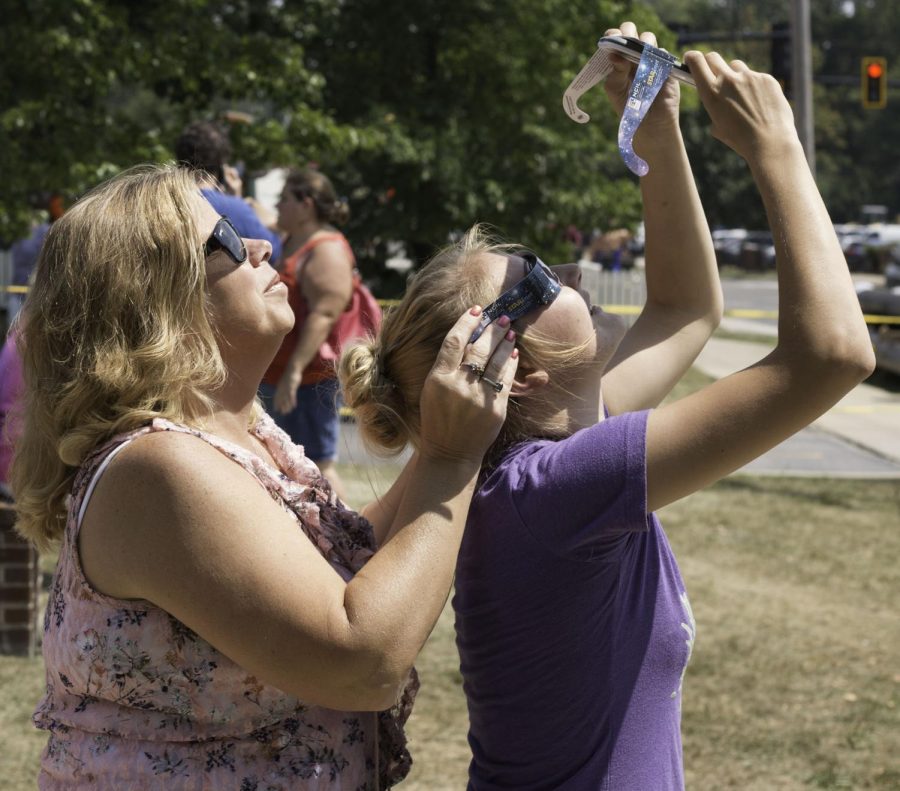Kent under partial darkness: Community gathers, witnesses rare solar eclipse
August 21, 2017
Across clear, open areas on Kent’s campus, small clusters of people and solo viewers had their eyes turned skyward to witness the 2017 solar eclipse on Monday — the first of its kind in the country in nearly 100 years.
The eclipse’s path of totality stretched across the United States, and while Ohio wasn’t one of the states completely shrouded in the darkness of the moon, those who gathered still saw a partial eclipse.
“ … You never know if the weather’s going to be as nice as it is today, so it could be literally a once-in-a-lifetime event,” said Dustin Lee, the video producer and editor of university communications and marketing.
Lee shot a time-lapse video of the event using a camera covered with neutral density filters.
“The screen is totally safe, because on this camera, it’s just an electronic viewfinder,” Lee said. “If you were looking through optics, like an older camera where you can actually see what you’re looking through the viewfinder, then it would be dangerous because that could still damage your eyes, but this is safe.”
According to Cleveland.com, 2:31 p.m. was the peak of the eclipse in Northeast Ohio with 80 percent of the sun covered, but viewers gathered earlier to watch the moon slowly obscure the sun.
“Actually, (I) saw it before once. I think that was like 2009 when I was in China, and at that time I was in the region that 100 percent of the sun is going to be covered,” said Shiyi Liu, a physics graduate student. “So it was a sunny day and just turns to be somewhere around the night, so it’s really cool and amazing.”
Others, such as those from the Office of the Provost, decided to take breaks and lunches outside to witness the event.
“Well, we’re all in the same office — the Provost Office — and this is a once-in-a-lifetime event, so we all saved our lunch and decided to come out here for this time,” said Melody Tankersley, the senior associate provost and dean of graduate studies.
Those with Tankersley shared four pairs of “eclipse glasses,” protective eyewear with extremely dark lenses made for safely viewing the solar event.
“ … You’ll basically burn out your retina if you look straight at the sun, so these are sort of like super, super, super dark. … If you were to look through them right now … I can’t see anything at all, so really, really dark,” said Mandy Munro-Stasiuk, the associate provost.
Others using the glasses included Nicholas Penman, a graduate student in the chemistry department, who described the view through the glasses.
“I mean, it’s kind of like when you’re looking at the moon and, you know, it’s crescent, or whatever. It’s very similar to that, except it’s orange,” Penman said.
The glasses, however, proved to be elusive to many, especially in the days just before the eclipse, with many stores selling out of the paper eyewear and listings on Amazon reaching exorbitant prices.
“There was a woman in our office who had like a batch of like 20 of them, so she like just gave this to me, but … this morning, I wasn’t sure if I could get any, so I went and bought a welding helmet,” Lee said. “But I’m going to return it now, (since there is) no need for a welding helmet after today. … I just got lucky.”
Some, like senior chemistry major Jonathan Markle, had not been able to find glasses at all, but wasn’t worried about potential damage to his eyes.
“I’m not planning on looking directly at it. I’m here just to enjoy the warmth,” Markle, who donned sunglasses, said. “Mostly, I’m kind of taking a break from studying. … the only way I’m looking at it is through pictures that I’m going to try to sort of move my phone around and attempt to sort of like take a picture of what’s going on, but I’m not looking directly at it, so no, I’m not worried.”
Others were utilizing more creative ways to witness the phenomenon, such as paper viewers.
“It’s an eclipse viewfinder from NASA’s website. You cut out the two circles that are on it, and if you hold it up, you have to have your back facing the sun, and if you point it at the ground, the eclipse will shine through the holes,” said Ashley Yurkovich, a senior nursing major who used her work break to see the eclipse.
“I’ve never seen one before. We have the livestream going upstairs, and so I just wanted to see it happening actually down here other than just the livestream,” Yurkovich said.
Rebekkah Berryhill, the groundskeeping supervisor, allowed others to look through a welding mask used for arc welders that she had brought for the occasion.
“I work for (University Facilities Management) and we have a weld shop there. … I asked if they had a rated lens that we could view the eclipse with, and they did, so I thought I’d take it out and take a peek myself,” Berryhill said. “If anybody else wanted to look, I was going to like, ask them if they wanted to see.”
Through the mask, the sun appeared wider than it did through glasses — a blazing, orange ball with an increasing veil.
“It’s just something that, like as a kid, I remember a few things coming through, but this was like … maybe once-in-a-lifetime,” Berryhill said. “Who knows what’s going to happen, like we could get hit by a bus tomorrow, so I just wanted to experience it.”
Cameron Gorman is a features reporter, contact her at [email protected].












